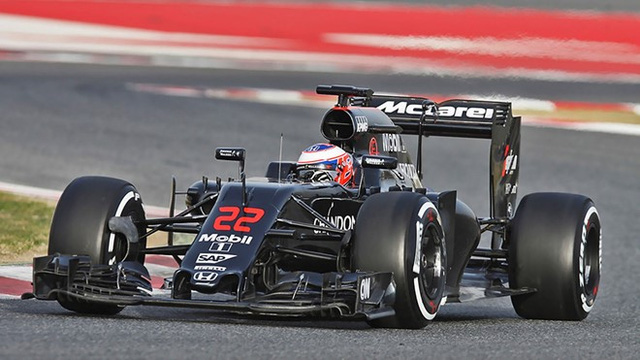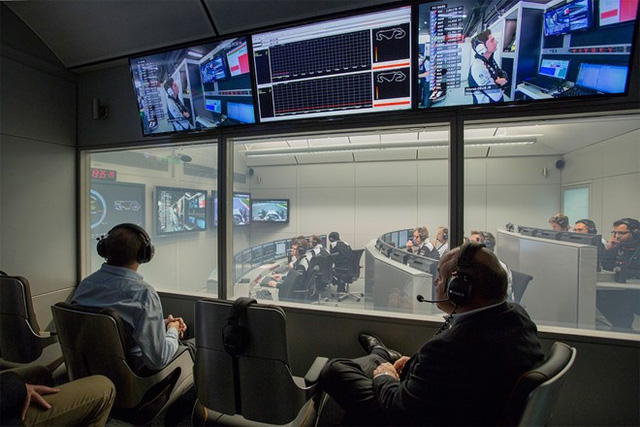Technology to create McLaren F1 supercar
Data from experiments and simulations have a very important role to make "monsters" on the Formula 1 track - McLaren F1.
McLaren F1 was created for the sole purpose of winning the race . Therefore, it needs to be the most perfect, the most powerful and without any extra details. McLaren has signed a 3-year technology support contract with partner NTT Communications (Japan) just to manage the data created by the McLaren F1 supercar.

McLaren F1 at the 2016 Grand Prix.
See how these valuable data are processed through the following steps.
Office of task control
McLaren's Mission Control room looks like a NASA spacecraft control room that we often see on film. The room has 3 rows of seats for auto engineers, strategists and aerodynamics specialists. All have degrees and full experience of science and math. The top line is 5 expert engine and powertrain monitors, the second row tests suspension and other components, while the last row is 3 race engineers.

McLaren's Mission Control room (Mission Control).
Here, data is everything. McLaren's supercomputer can run emulators of 300,000 races per second , then compare it with real-time racing supercar data to produce the best forecast models.
At Grand Prix , McLaren supercar is fitted with 300 different sensors, monitoring from brake force, tire pressure, vibration, G force . All are handled by expert groups. individual.
The role of data
Perhaps the task of controlling the task room is the busiest. Due to the rules of the F1 tournament, when the racing week started, the automakers were only allowed to make minor changes in the car. Big and important steps need to be completed before. In the monitoring room, the TV screen shows live images of the race. Each engineer has 2 screens placed in front of him. Data is constantly loaded up. A specialized team monitors the chart showing the lap time, vehicle speed, vehicle order and riders' own parameters such as acceleration, braking, gearbox control, or even cornering.
This group does not talk directly to the driver. Only engineers on the track can talk directly. However, the tracking team can still listen to radio conversations and exchange information with the team at the track through voice and text services. Exchanges, discussion of race conditions, fuel level, racing position are all closely analyzed and monitored to ensure the best conditions for riders.
The circulating information is handled exactly. Each race on the weekend will collect about 100GB of data. This data was obtained from sensors on the vehicle and immediately transferred to the task control room and to McLaren's engine partner, Honda. These units only have 15 minutes to analyze all data.

Tetsuya Shoji, CEO of NTT Communications (left) and Ron Denni, CEO McLaren (right).
With such a tremendous amount of time, NTT Communications ' role is more important than ever. This partner is responsible for transferring data to a safe place, ensuring that the system operates without any problems. " It's like a black-on-off sale, everything stretches like a string, doesn't allow any mistakes to occur," said Tetsuya Shoji, CEO of NTT, about data transmission from the track to the center. Handling of McLaren and partners.
Create supercar from race data
On Sunday night when the race is over, all collected data is once again processed in a different way. They are removed from mission control rooms to build predictive models, then combine with existing data to create new plans. After that, they were used to create super racing cars. Every 20 minutes, McLaren adds a new component to the car. This frequency is repeated daily. As a result, this year's McLaren F1 is 3.5 seconds faster than the 2015 version. All thanks to effective data management and processing techniques.

McLaren F1.
With McLaren, super computers and data from sensors are not all. The company has many years of experience in racing competitions. McLaren's management is enough to speak of that professionalism. Instead of selling or destroying retired racing cars, McLaren retains them all. There are 600 racing cars of this type in the warehouse, and it is an extremely valuable information store for engineers.
Future automation
The scope of McLaren's application of technology and data analysis processes is not limited to racing. The company is developing software for aircraft landing at Heathrow Airport (UK), the world's third busiest airport in 2015. In addition, McLaren also developed algorithms to help understand how things work, operating in environments with very little human impact.

McLaren develops software for aircraft landing at Heathrow Airport (UK).
" Automation will fundamentally change our world in the next 10 years ," said Ron Dennis, McLaren's CEO. By controlling and mastering data flows, this change is entirely possible, he asserted.
- Supercar has pictured
- Manufacturing materials for making supercar made from fruits
- Special points about the US President's
- Close up of the world's fastest electric car
- The car runs fast with a speed of 3,200km / h
- Model of air cushion technology super car of the future
- 1.600km / h supercar is about to run
- The new president's supercar reveals itself
- Super car project promotion
- The mystery of the
- Airbus's new aircraft can fly 20 hours without refueling
- Prioritize investment in science and technology to create a breakthrough
 America develops cruise missiles in formation
America develops cruise missiles in formation Develop smart contact lenses that the US military has been looking for for a long time
Develop smart contact lenses that the US military has been looking for for a long time 6 best DNS changing software for Windows
6 best DNS changing software for Windows Has found a solution to 'freeze' lithium ion batteries with liquid nitrogen, avoiding batteries to explode if there is a collision
Has found a solution to 'freeze' lithium ion batteries with liquid nitrogen, avoiding batteries to explode if there is a collision